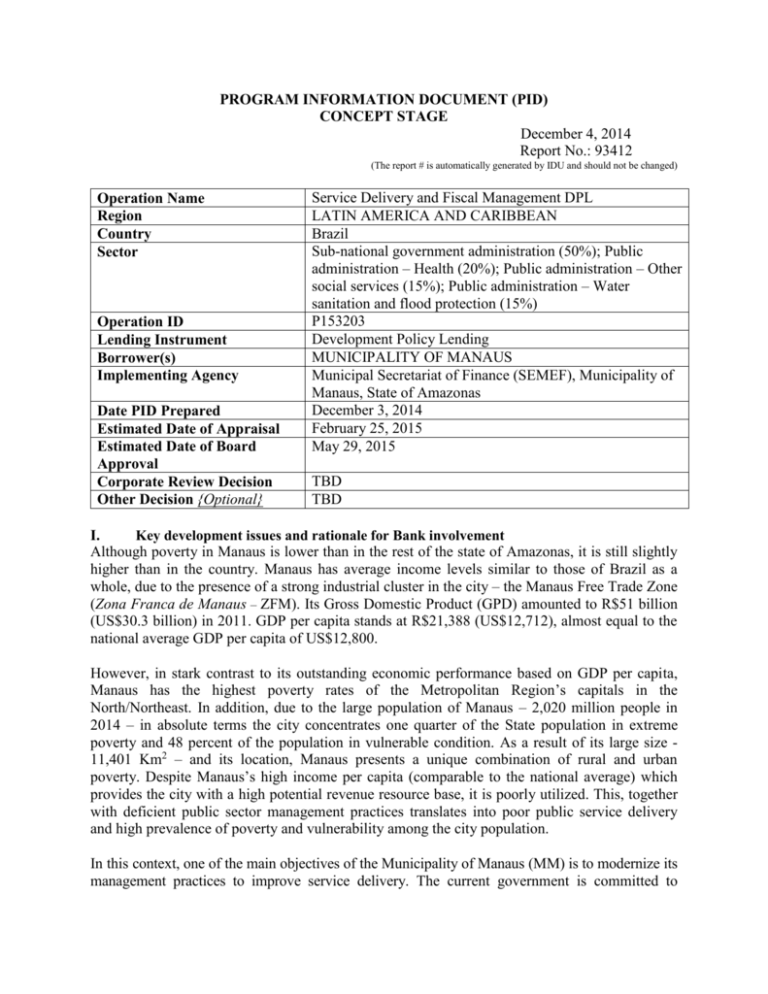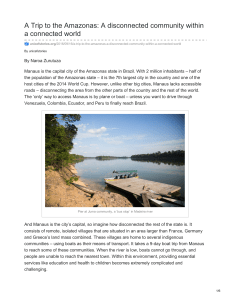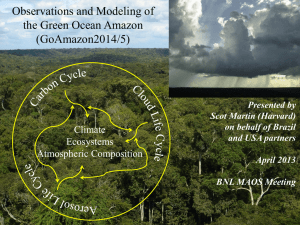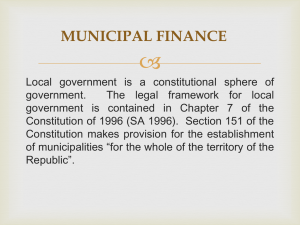PROGRAM INFORMATION DOCUMENT (PID) CONCEPT STAGE
advertisement

PROGRAM INFORMATION DOCUMENT (PID)
CONCEPT STAGE
December 4, 2014
Report No.: 93412
(The report # is automatically generated by IDU and should not be changed)
Operation Name
Region
Country
Sector
Operation ID
Lending Instrument
Borrower(s)
Implementing Agency
Date PID Prepared
Estimated Date of Appraisal
Estimated Date of Board
Approval
Corporate Review Decision
Other Decision {Optional}
Service Delivery and Fiscal Management DPL
LATIN AMERICA AND CARIBBEAN
Brazil
Sub-national government administration (50%); Public
administration – Health (20%); Public administration – Other
social services (15%); Public administration – Water
sanitation and flood protection (15%)
P153203
Development Policy Lending
MUNICIPALITY OF MANAUS
Municipal Secretariat of Finance (SEMEF), Municipality of
Manaus, State of Amazonas
December 3, 2014
February 25, 2015
May 29, 2015
TBD
TBD
I.
Key development issues and rationale for Bank involvement
Although poverty in Manaus is lower than in the rest of the state of Amazonas, it is still slightly
higher than in the country. Manaus has average income levels similar to those of Brazil as a
whole, due to the presence of a strong industrial cluster in the city – the Manaus Free Trade Zone
(Zona Franca de Manaus – ZFM). Its Gross Domestic Product (GPD) amounted to R$51 billion
(US$30.3 billion) in 2011. GDP per capita stands at R$21,388 (US$12,712), almost equal to the
national average GDP per capita of US$12,800.
However, in stark contrast to its outstanding economic performance based on GDP per capita,
Manaus has the highest poverty rates of the Metropolitan Region’s capitals in the
North/Northeast. In addition, due to the large population of Manaus – 2,020 million people in
2014 – in absolute terms the city concentrates one quarter of the State population in extreme
poverty and 48 percent of the population in vulnerable condition. As a result of its large size 11,401 Km2 – and its location, Manaus presents a unique combination of rural and urban
poverty. Despite Manaus’s high income per capita (comparable to the national average) which
provides the city with a high potential revenue resource base, it is poorly utilized. This, together
with deficient public sector management practices translates into poor public service delivery
and high prevalence of poverty and vulnerability among the city population.
In this context, one of the main objectives of the Municipality of Manaus (MM) is to modernize its
management practices to improve service delivery. The current government is committed to
eliminating the financial deficit generated in 2012 by the end of 2016. In order to achieve this
goal, the Secretariat of Finance (SEMEF) has introduced a results-based management model
with targets that include increasing revenue and expenditure reduction. These include the
institutionalization of transparent and efficient processes for the procurement of goods and
services and to control personnel expenditures, which are expected to result in greater efficiency
and efficacy in public spending. Similarly, the municipality is seeking to improve the quality of
its educational system by improving management practices such as the meritocratic selection of
school directors, establishment of school-level targets and the creation of minimum standards for
school staffing.
Over time, the city of Manaus has undergone considerable demographic and urban expansion.
Combined with poor urban planning, this expansion has resulted in severe and constant traffic
congestion. The average speed of the collective transportation system is 12 kilometers per hour,
leading to long commute times for poor people living furthest from the city’s center. To improve
urban mobility, Manaus is taking steps to improve traffic flows in the main corridors of the city,
prioritizing mass transportation over private vehicles, and promoting an overhaul of the city
center, an area that is now in decay. The MM has created a Secretariat to coordinate all efforts to
rejuvenate the Manaus City Center (Secretaria do Centro - SEMC) and create a business friendly
environment, while preserving the historical and cultural landmarks of the city center. This
strategy is aligned with the idea that it is more cost-efficient to rejuvenate central areas of a city,
attracting people back than to expand the urban footprint, especially in a city surrounded by a
protected ecosystem.
II.
Proposed Objective(s)
The Program Development Objective (PDO) of this proposed operation is to assist the MM to
implement sound practices in the areas of public sector and fiscal management in the support of
improved innovative service delivery in transportation, education and urban management. By
supporting the mobilization of revenue and the introduction of more modern public sector
management practices, this operation will allow the municipality to expand and upgrade public
service delivery in the areas of education, transport and urban services, which benefits mostly the
poor and the vulnerable share of the population, and thus contributing directly to the World
Bank’s twin goals of ending extreme poverty and promoting shared prosperity.
The policy areas covered by this operation aim to support the MM’s own goals in the areas of
public sector management and service delivery. Therefore, the PDO is fully aligned with the
local administration’s longer-term development objectives. Furthermore, the proposed operation
also complements other programs under implementation by the State of Amazonas aimed at
improving their fiscal position and the quality of public sector management. For instance, the
World Bank and IADB-supported Program of Consolidation of Fiscal Equilibrium for Social and
Economic Development in the State of Amazonas (Programa de Consolidação do Equilíbrio
Fiscal para o Desenvolvimento Econômico e Social do Estado do Amazonas - Proconfins) from
SEFAZ.
The expected results from this operation are improvements in public sector management and
performance, increased fiscal sustainability and enhanced service delivery in education and
transport through increased efficiency and expenditure control. These efficiency gains will be
perceived through several channels such as the implementation of streamlined procedures, and
implementation of best practice policies and systems for resource management, procurement,
and human resources (in local administration and in the education sector) resulting in public
sector savings; increased local tax compliance; and improved urban mobility. Given the breadth
of these reforms, these measures would benefit all citizens of Manaus, but in particular those in
vulnerable groups who are more dependent on government services.
From the area of financial management, procurement and human resources, several results are
expected. In the areas of financial management and procurement the expected results include (i)
an increase in fiscal sustainability through the implementation of results-based management
model for the SEMEF with action plans and indicators that target financial goals; (ii) increases in
the speed and transparency of public procurement through the use of electronic bidding and the
Manaus Compras open access website to award contracts; and (iii) reductions in the cost due to
the adoption of a centralized system for implementing framework agreements as well as through
the implementation of a payroll audit routine and the establishment of a unit to manage Manaus’s
employee pension fund. In the area of the tax administration results are intended to reduce
default rates and increase local tax revenue by implementing of new procedures for collecting
overdue taxes, including criteria for payment installments, and establishing various channels of
communication with taxpayers. Within the area educational management the expected results
include (i) improvements on Basic Education Development Index (Índice de Desenvolvimento da
Educação Básica – IDEB) scores through the implementation of a new Integrated School
Management Model (Gestão Integrada da Escola – GIDE); (ii) increases in the number of
school directors selected through meritocratic processes; and (iii) more efficient allocation of
faculty and staff in schools through the adoption of a Minimum Standard Framework to regulate
the appointment and dismissal of education professionals. In the areas of urban organization and
transport expected results include (i) rejuvenation of the Manaus city center through the adoption
of an integrated urban regeneration policy; and (ii) improved urban mobility and reduced travel
time through enhanced urban bus management, traffic light coordination as well as policies to
improve traffic flow in critical corridors.
III.
Preliminary Description
The proposed operation is a one-tranche Development Policy Loan (DPL), in the amount of
US$150 million to the municipality of Manaus, in the State of Amazonas, Brazil and supports
the program of the MM in areas of public sector management, education and urban transport and
organization. The operation is structured around three pillars: (i) a financial management,
procurement, human resources, and tax administration pillar; (ii) an educational sector
management pillar; and (iii) an urban organization and transport pillar.
Pillar I. Improved Public Sector and Fiscal Management. The main objective of this first pillar
is to improve public and fiscal management in the municipality, starting with SEMEF. The main
reforms aim at increasing tax collection, improving efficiency, savings and transparency in
procurement procedures, and controlling expenditures.
Due to expenditure arrears and lack of financial backing, the city government ended the year of
2012 with a deficit of R$ 360 million. This situation began to be reversed in 2013 with a strong
review and contingency of expenditure, along with measures to increase revenues. In order to
achieve fiscal sustainability, the SEMEF gave vital importance to the introduction of modern
management tools in public administration. In 2013, SEMEF created an undersecretary for
management for results (Gestão por Resultados) which developed goals and action plans, and
trained employees in the PDCA (Plan, Do, Check and Act) methodology. The goals are
monitored and action plans discussed weekly. The intention is to gradually expand this
methodology to other secretariats of the MM, thus enhancing the overall capacity of the MM to
deliver services. In total, approximately 25 indicators and targets are being monitored, such as
for the collection rate of own revenues such. The proposed actions of the operation support the
meeting of some of these establishment indicators.
The MM also has made strides to improve efficiency and transparency in the areas of (i)
institutionalizing e-Procurement and disclosure of procurement processes; (ii) implementing
framework agreements; (iii) establishing routine payroll audits; and (iv) improving pension
management. The proposed actions of the operation support the adoption of the new policies,
streamlined procedures and systems that will allow the MM to improve efficiency and financial
control of resources, thus generating savings.
Regarding tax administration, practices in Manaus are catching up with national best practices.
As part of a larger reform plan in tax administration, the Municipality has implemented a
structured routine to recover tax arrears and has reduced the possibilities for delinquent taxpayers
to consolidate and pay their arrears in favorable conditions. SEMEF prioritized the recovery of
arrears from large taxpayers and adopted alternative mechanisms for small taxpayers such as
resorting to credit bureaus. It has also formally instated a procedure to send email and SMS
notifications to taxpayers to remind them of the upcoming payment dates as well as to call
taxpayers soon after they have missed payments. These proposed reforms promote increases in
tax compliance rates.
Pillar II. Enhanced Management and Quality of the Educational System. Policy actions to
be supported under this pillar aim at improving the quality of the municipal educational system
via enhanced management practices. This objective will be achieved through the meritocratic
selection of school directors, establishment of school-level targets and the creation of minimum
standards for school staffing.
The municipal school system is lagging behind according to the results of the Basic Education
Development Index (Índice de Desenvolvimento da Educação Básica – IDEB). Although the
school system has made improvements in recent years, Manaus remains ranked only 20th out of
27 capitals in Brazil based on IDEB scores. Performance in other education indicators has also
been weak over the last decade as age-grade distortion, repetition and dropout rates are also high.
In this context, the main objective of the Municipal Secretariat of Education (Secretaria
Municipal de Educação E Cultura - SEMED) is to improve the quality of the municipal
educational system. To support this objective, SEMED has implemented a new Integrated School
Management (Gestão Integrada da Escola - GIDE) model. This reform has already been
implemented in many educational systems that have significantly improved the proficiency
levels of its students, such as Minas Gerais, Rio de Janeiro, Pernambuco and Ceará. In MM, this
model was aligned with two policies implemented in 2012: (i) the Secretariat’s and schools’
Targets Plan, and (ii) the school-level bonus pay program to achieve IDEB targets.
Moreover, SEMED aims to strengthen the management of municipal school through an
accreditation process of teachers as potential school directors and a new merit-based selection of
school directors. The Secretary will appoint the school directors in a transparent manner, based
on their performance in the accreditation, for a three-year period contract, renewable for another
three years. If the appointed directors do not achieve the IDEB targets, they can be replaced by
other certified teachers. Staffing of schools also poses a challenge for SEMED. To address this,
SEMED is defining clear and objective rules for the allocation of school staff to support the
continuity of pedagogical programs, taking into account the number of classrooms in schools.
Pillar III. Improved Mobility and City Center Regeneration. Policy actions to be supported
under this pillar aim at improving urban mobility in Manaus, as well as to rejuvenate the city
center. This objective will be achieved through policies to improve traffic flow in the main
corridors of the city, prioritization of mass transportation over private vehicles, and an overhaul
of the city center, an area that is now decadent.
To recover public space in the city center, the MM has created a Secretariat to coordinate all
efforts to rejuvenate Manaus City Center (Secretaria do Centro - SEMC). The strategy of this
Secretariat is to create a business friendly environment at the city center, to attract and maintain
private investment conciliating at the same time these investments with the preservation of
historical and cultural landmarks of the city center. To achieve this, the SEMC has adopted an
innovative policy to relocate and integrate street vendors into formal sector through training on
entrepreneurship and registration under the category of Individual Micro Entrepreneurs (Micro
Empreendedor Individual - MEI) as well as relocation into refurbished historical buildings where
comprehensive municipal services will also be available in order to generate pedestrian traffic.
MM also faces growing challenges in mobility associated with the absence of urban planning.
With the purpose of improving mobility and reducing ravel time, the municipality has
implemented policies to improve and upgrade traffic lights' coordination and interaction with the
bus system operation. The objective of this activity is to reduce travel time, prioritizing bus
movement around the city, through improved information and interaction with buses.
Components under this activity include the replacement of the outdated bus management system
currently in use and installation of a new traffic command-control center. .
Poverty and Social Impacts and Environment Aspects
Poverty and Social Impacts
Preliminary analysis suggests that:
i)Improved quality of public schools may have long-term positive distributional effects in a city
in which levels of income are so deeply related with school attainment. Teachers and students
from municipal schools might be the most benefitted from improvements in the quality of public
schools envisaged under the proposed policies. These students may probably come mostly from
low-income families. The municipal school system operates 362 schools, which attend more than
168 thousand students (46.8 percent of all students enrolled in the elementary school). The
system hires 5,148 teachers.
ii) Formalization, retraining and relocation of street vendors may benefit the most extreme poor
laborers, because they may increase labor security, improve incomes and promote access to
social policies/security nets. An assessment of street vendors carried out by the city`s
government has identified 2,081 street vendors who, in their huge majority (95.6 percent), have
just this economic activity as source of their livelihood. The average income of the majority of
them (67 percent) equals less than three minimum wages and just 13.4 percent of them have
access to credit lines. Nevertheless, 68.6 percent of them do not have interest on looking for
other jobs. Most of them have not completed secondary school. Women count for a significant
share of these street vendors (45.4 percent).
iii) Policies of urban mobility may bring the most benefits for people living in the newest,
poorest and most remote neighborhoods, which are poorly served by the collective transportation
system. The city of Manaus has observed large demographic growth and urban expansion, which
generates a demand of 3 million trips daily. Collective public transportation answers to 46
percent of this demand, whereas cars are used in 12 percent of them and 28 percent are still done
by foot. Poor urban planning is associated with the absence of planning of new bus lines.
Consequently, the fleet of 1,620 buses attends 244 bus lines that often follow similar routes in a
radial system, in which most of the lines start or end at downtown Manaus. Urban mobility also
faces the challenge of a growing number of motorbikes and cars, which increased 382 and 142
percent, respectively, from 2001 to 2011. Consequently, traffic jams are a constant and the
average speed of the collective transportation system is 12 kilometers per hour, leading to large
times spend by poor people commuting.
iv) Finally, the policy related with public servants` pension system is critical to overcome the
trend of increasing municipal debts due to the payment of pensions and to ensure the long-term
sustainability of the pension system and the compliance with labor rights of retired public
servants.
The Poverty and Social Impact Analysis (PSIA) will focus on the policies that may have the
most direct distributional impacts – namely: those related with improvements in the educational
sector, public servants’ pension system, urban regeneration, and urban mobility. The PSIA will
carry out a desk review of census data and other secondary sources as well as primary
consultations with key stakeholders, including: representative organizations of school teachers
and principals, street vendors and commercial associations, civil servants unions, representatives
of users, providers and regulating agencies of public transportation in the city – to assess their
views of the proposed policies, identify the potential distributional impacts on the short and longterm these policies may cause, and to understand how they will affect different social groups.
The analysis will rely on gender-sensitive indicators.
IV.
Tentative financing
Source: IBRD
Borrower: Municipality of Manaus
($ 150 million)
0
Total
$ 150 million
V.
Contact point
World Bank
Contact: Laura De Castro Zoratto
Title: Economist
Tel: (202) 473-0940
Email: lzoratto@worldbank.org
World Bank
Contact: Rafael Barroso
Title: Economist
Tel:
Email: rbarroso@worldbank.org
Borrower
Contact: Ulisses Tapajós
Title: Secretary of Finance (SEMEF)
Tel:
Email: ulisses@acaoi.com.br
VI.
For more information contact:
The InfoShop
The World Bank
1818 H Street, NW
Washington, D.C. 20433
Telephone: (202) 458-4500
Fax: (202) 522-1500
Web: http://www.worldbank.org/infoshop









